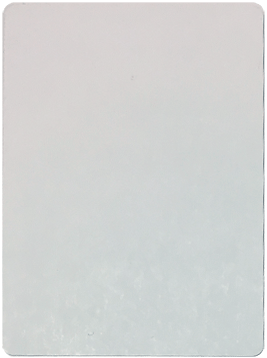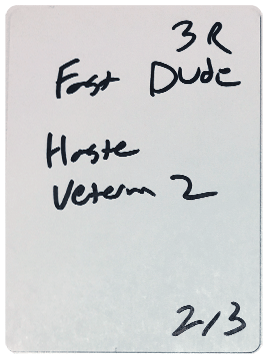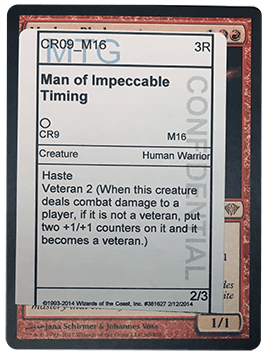Playtest Cards
Hello and welcome to another edition of Latest Developments. Today I'm going to be talking about one of the more important physical objects for day to day work on Magic sets—the playtest cards.
Anatomy of a Playtest Card
The most basic kind of playtest card we have is perhaps the most obvious: blanks.

We use these mostly in early design when putting a lot of cards that will likely get thrown away into a database may not be worth the time. Usually these are used when testing new mechanics, or when you are Future Future League-ing and want to quickly throw a card in your deck. It's really simple—you just get out a pen and write on the card.

Once the cards are actually put into a database and printed, there is a more rigorous process for putting all of the needed information onto the card. I'll go into the details of what appears on the card in a second, but first let's see what they look like:

Card Number and Set: This very important, because we have a lot of cards in motion at any given time and names are liable to change. Including the card number and set lets people quickly identify where the card is from if they are curious in terms of where it is in the process. The difference between a card in early design and late design is pretty substantial if you notice a problem with the card.
Name: I'll get more into this later. The goal here is to give it something memorable enough that people can talk about it in a meeting and know what it does. It can be cute, but it should describe the card well. Zac's Prize-Winning Jug Band may be a fun playtest name, but it's likely to be more of a distraction than its worth, at least by the time a set gets to development.
Color: When we sticker cards, we sticker them onto cards of the same color. We get thousands and thousands of cards from the printer as part of the process of proofing cards and having stock to use for spell-slinging. The extras end up getting used for this purpose. Because we don't have art (or really even a lot of color) on our playtest cards, we get the illusion of color through what we sticker the card on. It helps, especially as we fan cards out in a draft pack, to quickly figure out which cards we need to focus on and which we can ignore.
The biggest challenge with this are gold sets (since our real gold cards actually reflect the colors of the cards), and sets like Battle for Zendikar that have a strong frame "gag" going on. BFZ was particularly hard because if we used colored cards, it would be very difficult to tell whether a card was devoid or not. If we used colorless cards, then it would take longer to scan packs.
Casting Cost: Our sticker-printing tool does this automatically, converting the number in the top right to the symbols you are used to seeing. We don't always have a symbol to use, though. When we do decide to come out with a new type of mana that requires a new symbol (like in New Phyrexia and Oath of the Gatewatch), we often stick to letters in the casting cost.
For example, during Oath of the Gatewatch playtesting, we used the letter K for all the "colorless-only" mana costs (since they were "Kozilek mana"), and our sticker-printing tool was picking up C as a different symbol. It was very easy to tell when looking at cards what the mana cost was, even if you needed an explanation before your first time seeing them. We quickly moved away from that, for reasons, once we had the opportunity to update our tool and we knew the mechanic would stick.
Creature Type: It's on the person working on the file to make sure these are reasonable enough, and don't do anything disruptive. For instance, making a set full of "Creature — Wiener Dog" might be fun, but you may get more comments on that in your playtest than on the actual cards. Better to go with the standard Creature — Hound. If (for some reason) creature type is relevant in a set, we put an exclamation point after the creature type to let creative know that this needs to be that type. Simply naming it isn't enough, as your Hungry Zombie could become a Hungry Human when creative writes the art description and sends off their commission. If your set—and the sets around it in Standard—don't have any need for Zombie tribal, that could be fine. But if people were FFLing with that card in their Zombie decks and it suddenly becomes a Human, you may be faced with either disrupting their decks or a recommission.
The required creature type isn't just for Limited and Standard, though; there may be other reasons that you set the creature type in stone. For example, when working on Magic Origins, I made sure that Harbinger of the Tides was a "Merfolk!," not because of anything in Standard, but because it was a card I wanted to aim at a Merfolk deck in Modern and Legacy. Deadbridge Shaman got a "Elf!," on the other hand, because it was needed for the Elf deck in Limited.
Text Box: The goal here is to make sure you don't have too much text for a textbox and that you have close enough wording to make things work. If your card is too colloquial or wrong, people will play it wrong. If you bury the important part of the card in reminder text somewhere, people will miss it. We want clear and concise instructions that get you to play the cards as they are intended for the playtest—whether or not it matches up to how cards are templated in the real world.
Now, there are opportunities for rogue templating here that happens at points in design. During Shadows over Innistrad design, we experimented with some different wordings for "Put the top X cards of a library into a graveyard" to see if we could find a word that people intuited the same way they did for "dies." "Dies" was something that many people would react to without blinking—because it was how they referred to it already. Using "forget" for milling just didn't resonate the same way. And "milling" has only ever worked because of how in-tune everyone in the pit is to Magic lingo, but it would not work for your average person who is picking up the game anew. It's possible that we may come up with our simplified wording for mill someday, but we certainly haven't gotten to it yet, though we do try every few years.
Power/Toughness/Loyalty: This one is pretty simple. This is one area we tend not to get too creative in; this part of the card should just reflect reality.
Good Names, Bad Names
The point of playtest names isn't just to be functional. We're making a game, and that means having fun. We like using names that evoke something in the person reading them.
7G
Uh-Oh, Rhino
Sorcery
Put a 4/4 green Rhino creature token with trample onto the battlefield, then populate. (Put a token onto the battlefield that's a copy of a creature token you control.)
"Horncaller's Chant" is the right name for the card, in the end, due to the worldbuilding and tone we are going for in the game. But the name "Uh-Oh, Rhino" is pretty adorable, and having such a great name is a good way to make sure people actually test the card.
This is also important in sets with top-down elements. The Theros block had a lot of references to Greek mythology. We often take these top-down cards and give them very on-the-nose names to make sure that people will understand the references without the aid of art. For example, this card was in the Theros file for a long time:
4
Trojan Horse
Artifact Creature — Horse
Defender
When CARDNAME enters the battlefield, an opponent gains control of it.
At the beginning of your upkeep, each opponent puts a 1/1 white Soldier creature token onto the battlefield.
This card name implied a history that wasn't all great from a creative standpoint, though. Due to the desires of the creative team to separate real-world myths from Theros's mythology, the card became:
4
Lion of Foreign Lands
Artifact Creature — Lion
Defender
When CARDNAME enters the battlefield, an opponent gains control of it.
At the beginning of your upkeep, each opponent puts a 1/1 white Soldier creature token onto the battlefield.
The gag here was that it wasn't a Horse like in the Greek myth, but a Lion. The problem was that the second we changed the playtest version away from being a Horse, people stopped getting it. There was some chance that a combination of art and explaining it to people would solve the confusion, but we only have that option with our most enfranchised players. Someone who is new to the game might pull this from a pack, and they may totally miss the reference.
The names we put on cards in playtesting are important. As we found out with this one, the total package just wasn't working.
The goal of playtest cards should be to convey the things that we want in a final card. If it is trying to convey something, the playtest name should make that clear. If it serves an important role, the playtest name should convey that. Perhaps more important than that, though, is that playtest names shouldn't trip people up or confuse them. Burn spells should sound like burn spells. Counterspells should sound like counterspells. And we need to be careful that we don't distract people or mislead them with the names.
Imagine this card:
R
Light-Ting Bolt
Sorcery
CARDNAME deals 2 damage to target player.
Beatings (If you attacked with two creatures this turn, when you cast CARDNAME from your hand, put a copy on the stack. You may choose new targets.)
So, the gag here is that it's not Lightning Bolt, but Light-Ting Bolt. Like Beatings. Get it? Except, everyone knows what Lightning Bolt is. This card, on the surface, looks very similar to Lightning Bolt—one mana cost, deals damage. The name is cute, but it's going to trip a lot of people up as they build Sealed/Draft decks or cast it. It's something fun to type in a file, but it risks messing up a playtest.
Ultimately, we like to have fun making up cards, but we need to be careful that our fun typing things into our database doesn't take precedence over good playtesting procedures. We want our cards to be clear and our testing to not be tainted by either using old, out-of-date cards (which is why it is so easy for us to print new cards now) or by people misunderstanding what a card does because of the wording or name.
That's it for this week. Join me next week when I answer your questions in a mailbag column.
Until next time,
Sam (@samstod)
